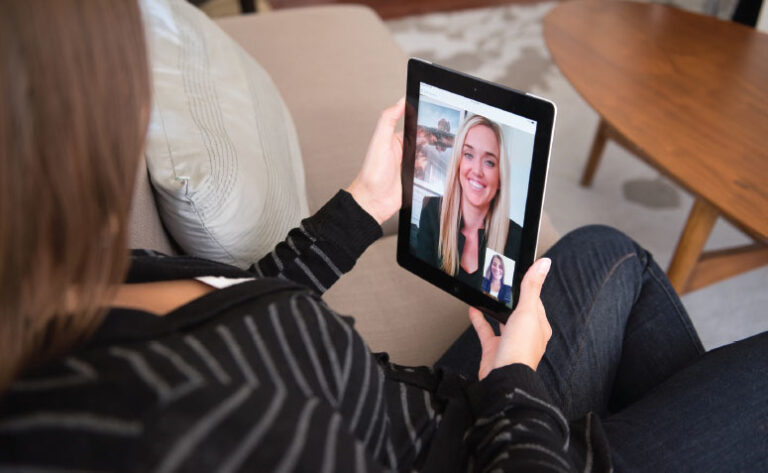It wouldn’t have been imaginable at the 2011 opening of the Masonic Center for Youth and Families (MCYAF). But soon, MCYAF therapists will be able to reach children who need their specialized therapeutic services in even the remotest regions of California.
MCYAF, which has clinic sites in Covina and San Francisco, is preparing to pilot a telehealth program, enabling Masonic families to meet with counselors over a secure video connection from home. Over the next 10 years, telehealth is projected to be part of most hospital, pharmacy, and employer business models. For MCYAF, it extends crucial mental health services to remote communities, and families who are hesitant to seek help in person. For many young people — for whom interacting through a screen is the norm — telehealth can feel safer than talking in person, and early research suggests it may have similar outcomes as a face-to-face visit.
“A lot of people use smartphones to connect, and it’s impacted our field significantly,” says Jenna Kemp, MCYAF clinician and project coordinator. By using new technologies in a positive way, MCYAF can reach families no matter where they live — while breaking down barriers of stigma and shame that might have prevented them from seeking needed care.
“Imagine the impact for every vulnerable child who can’t travel to one of MYCAF’s clinics,” Kemp says. “This is the wave of the future.”
An eye for innovation
From its programs for children to its early focus on successful aging, the Masonic Homes of California has always had an eye for innovation — and thanks to the generosity of California Masons, the resources to pursue it. In the future, the Homes will be able to do even more.
Consider what the next few decades could bring for outreach. More and more seniors are choosing to age at home, a trend the Homes responded to in the early 2000s by creating Masonic Outreach Services (MOS). Today MOS and lodges have stretched a safety net throughout California, connecting elder brothers and their spouses with services that help keep them safe at home. Imagine how this mission could be maximized with the advent of new technology. Floor sensors track footstep patterns and warn of potential falls. Webcams will allow elders to see the faces of their loved ones at the push of a button, and give caretakers the ability to keep an eye out for their well-being. Simple robots will soon track whether medication is being taken, help with cooking, and assist with household tasks. Most of these gadgets are already available in some markets, and their cost and effectiveness improves every day. With resources and support, MOS could help fraternal family integrate them into their lives, and enter a new era of aging at home.
Masonic Homes residents will be part of the changing tide. At last year’s Masonic Communities & Services Association Conference, the Union City campus furnished two “Smart Home” apartments: living spaces retrofitted with cutting edge technology. They provided a glimpse of how Internet-connected household items (for example, the Amazon Echo and a responsive lighting system) can be inexpensively integrated into existing architecture to improve safety and quality of life. A sensor triggers soft floor lights when a resident gets out of bed in the middle of the night; another switches living room lights off when they leave. Wearable devices that track heartbeat, respiratory rate, and movement patterns could guide medical care plans. And thanks to its northern campus’s proximity to Silicon Valley, the Homes has a unique opportunity to set the bar for integrating technology in senior care.
The future will show up on campus in other ways. A culture shift is taking place in senior care, reflecting Baby Boomers’ desire for activity, autonomy, and high-end amenities. The Masonic Homes master plan, Roadmap 2020, embraces this new ethos by emphasizing vibrant communities and person-directed care. This means that the fraternity can lead senior care in its infrastructure, as well as philosophy. Last year, the Transitions short-stay rehabilitative and respite care program opened on the Union City campus, offering hotel-style amenities for residents and clients recovering from neurological, cardiac, and other surgeries. New skilled nursing facilities are already planned for both campuses. Community centers will be at the heart of each campus. Old, outdated buildings will be updated to reflect best practices in the design of senior living spaces.
Partnerships will be vital for the future of health care, and the Homes has already been able to nurture key relationships: Last year, the Masonic Homes worked with Washington Hospital on a short-stay rehabilitative and respite care program for the Home’s Union City campus, and both campuses recently partnered with professor and researcher T.J. McCallum, who uses technology to combat memory loss. The Masonic Value Network was introduced, providing a list of reputable independent providers for Masonic families statewide to consider for their care needs. These examples are mere previews of what the Homes may achieve in the years to come — from new care services to research contributions, and perhaps someday, preferred provider relationships and rates for California Masonic families.
A new era for fraternal relief
When it comes to helping families in the immediate future, MCYAF is focused on educating Masonic youth orders about all of its services, including the new telehealth initiative. This could lead to a broader telehealth rollout down the road. Kimberly Rich, MCYAF’s executive director, hopes MCYAF can eventually build relationships with public schools, so more at-risk families will know where to turn for quality mental health care.
“California Masons are bringing high quality care to families who wouldn’t otherwise have access to it, and to children who really need the support,” says Rich. “This goes back to the Masons’ obligation to take care of others. They’re doing it to leave the world a better place than they found it.”
By Laura Benys

